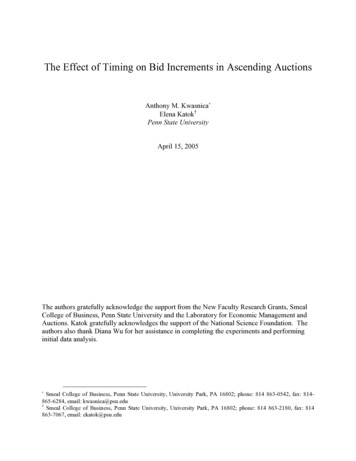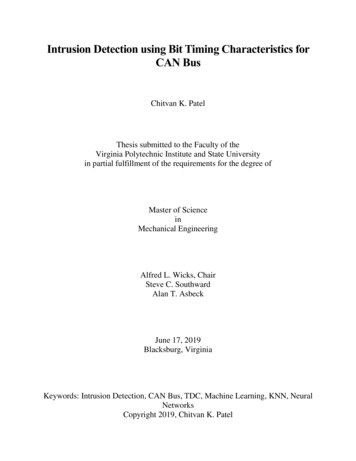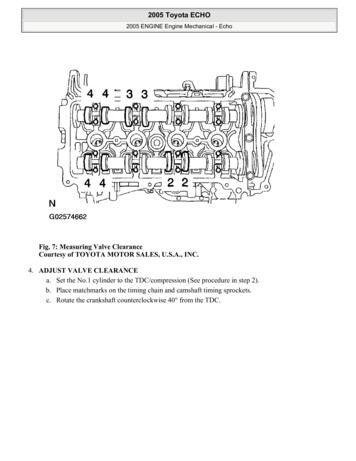
Transcription
The Effect of Timing on Bid Increments in Ascending AuctionsAnthony M. Kwasnica Elena Katok†Penn State UniversityApril 15, 2005The authors gratefully acknowledge the support from the New Faculty Research Grants, SmealCollege of Business, Penn State University and the Laboratory for Economic Management andAuctions. Katok gratefully acknowledges the support of the National Science Foundation. Theauthors also thank Diana Wu for her assistance in completing the experiments and performinginitial data analysis. Smeal College of Business, Penn State University, University Park, PA 16802; phone: 814 863-0542, fax: 814865-6284, email: kwasnica@psu.edu†Smeal College of Business, Penn State University, University Park, PA 16802; phone: 814 863-2180, fax: 814863-7067, email: ekatok@psu.edu
The Effect of Timing on Bid Increments in Ascending AuctionsAnthony M. Kwasnica and Elena KatokWe investigate the role of timing in ascending auctions under the premise that time is a valuable resource.Traditional models of the English auction ignore timing issues by assuming that the auction occursinstantaneously. However, when auctions are slow, as internet auctions used for procurement often are,there are significant opportunity or monitoring costs to bidders, and the choice of the bid increment levelbecomes a strategic decision. We study the choice of bid increments in the experimental laboratory bysystematically altering the opportunity costs associated with fast bidding. We find that when time is morevaluable bidders respond by bidding larger increments. Surprisingly, the economic performance of theauction is not significantly affected. We develop a simple model of ascending auctions with impatientbidders that provides insights into the effect bid increments have on auction performance.Keywords: Auctions, Experimental EconomicsJEL Classifications: D44, C911. Introduction and related literatureThe advent of the Internet has provided new opportunities for the use of auctions ingeneral, and for the use of procurement auctions in particular.The use e-Sourcing1 forprocurement has been increasing over the past decade, with total revenues projected to exceed 3billion by 2005.2 Auctions are typically used as part of e-Sourcing technologies, and haveattracted considerable attention when General Electric claimed savings of over 600 million andnet savings of over 8% in 2001 by using SourceBid, a reverse auction tool that is a part of GE’sGlobal Exchange Network (GEN).3 Other examples of the use of electronic auctions forprocurement include the U.S. General Services Administration (Sawhney 2003) that attributed1E-Sourcing refers to the use of internet-enabled applications and decision support tools that facilitate competitiveand collaborative interactions among buyers and suppliers, through the use of online mechanisms including,specifically, reverse auctions. See Engelbrecht-Wiggans and Katok (2005) for a discussion of the use of e-Sourcingmechanisms for procurement.2According to a September 2002 report by the Aberdeen Group (Aberdeen Group 2002), e-Sourcing revenuesincreased from 820 million in 2001 to 1.14 billion in 2002, and are projected to increase to 3.13 billion in 2005.3According to a case study written by GE’s Global Exchange Services (Global Exchange Services 2003), GE’sGlobal Exchange Network is used by about 35,000 suppliers and handles over 10,000 e-invoicing enquiries per day.Approximately 37,000 reverse auctions, worth about 28.6 billion, have been conducted between 2000 and the 2ndquarter of 2002, generating 680 million in savings in 2000-01 and additional 900 million in savings projected for2002.-1-
savings of 12% to 48% to the use of reverse auctions, and FreeMarkets—the leading on-lineauction software provide— that saved approximately 20% for their customers on over 30billion in purchases between 1995 and 2001.The Internet allows geographically dispersed bidders to compete on price, potentiallyleading to lower costs for the buyers, and Internet auctions typically last anywhere from a fewhours (FreeMarkets) to over a week (eBay). The Internet technology puts a limit on how fast anauction can run because issues such as network congestion must be considered. Besides theInternet, there are a number of other settings such as complex combinatorial auctions anddepartment store sales (see for example Carare and Rothkopf 2005), in which fast auctions arealso not feasible. But standard auction theory does not consider the role of time in auctions; itassumes that all auctions occur instantaneously. As applications for slower auctions becomemore prevalent, the issue of time, its associated costs, and the effect these costs have on biddingbehavior, become more relevant, and our work aims to start filling this gap.In Katok and Kwasnica (2004) we focused specifically on two common auction formats:the Dutch or reverse clock auction, and the first-price sealed bid auction. While these auctionsare strategically equivalent under the traditional assumptions of auction theory, they varymarkedly in terms of the role of timing. In the Dutch auction, a decision to stop the clock at ahigher price is also a decision to end the auction earlier. In the first-price sealed bid auction, thebidders have no direct ability to control the time at which the object is sold. However, in bothcases, the auction designer can make important design choices based upon the importance oftiming; he can select different clock speeds (Dutch auction) or decide on different closing timesfor accepting bids (sealed bid auctions).-2-
In Katok and Kwasnica (2004) we develop a simple theory of Dutch auctions withimpatient bidders, and test this theory in the laboratory by comparing four institutions: thesealed-bid first-price auction, and the Dutch auctions with three different clock speeds (slow,medium, and fast). We find that, contrary to standard theory but in line with our theory ofimpatient bidders, the auctioneer’s revenue increases as the clock slows. In addition to providinga valuable insight for auction designers, our work also provides an explanation to an importantanomaly in the experimental auction literature: Cox et al. (1982) report that fast Dutch auctionsin the laboratory yield lower revenue than sealed-bid first-price auctions, but Lucking-Reiley(1999) reports the opposite result for a slow Dutch auction conducted over the Internet. Ourtheory of impatient bidders organizes that data, as well as our own data, that compares theinstitutions in a more controlled way. Carare and Rothkopf (2005) describe a decision theoreticmodel of a slow Dutch auction that can also explain some of the differences.In the present paper we extend our work in Katok and Kwasnica (2004), and investigatethe role of bidder impatience on bidder behavior in English auctions. The English auction is anopen outcry, ascending auction; bidders are free at any time to bid amounts greater than thecurrent high bid and possibly some minimum increment, and the winner is the bidder who placedthe last high bid. As in the Dutch auction, bidders in the English auction can take actions toreduce the costs associated with slow auctions. The most obvious strategy is to jump bid or to bidan amount greater than the minimum increase required by the auctioneer. The empiricalrelevance of jump bid has been widely noted in a number of settings including some of thelargest, highest revenue auctions. Isaac et al. (2004) examine 41 spectrum auctions conducted bythe Federal Communication Commission (FCC) and find that jumping bidding is a persistent andcommon (sometimes upward of 40% of the bids) feature of these auctions. Jump bidding may-3-
allow a bidder to reduce the costs of slow auctions by speeding up the auction, but this strategymay also affect auction performance. In the process of bidding, the bidder might inadvertentlypass by the second highest bidder resulting in foregone profits for the bidder, or the bidder mightstop bidding early causing reduced revenue for the auctioneer. While a number of experimentalstudies have suggested that jumping bidding may be detrimental to auction performance (Bankset al. 2003, Porter et al. 2003), our study systematically varies the incentives for jump bidding inorder to observe whether this affects the overall performance of the institution. Most previousstudies have focused on the value of jump bidding as a technique for bidders to signal theirvalues. In an affiliated value setting (Avery 1998) and in a private value setting with costlybidding (Daniel and Hirshleifer 1998), previous studies have shown that there exist equilibriawhere bidders place large jump bids early in order to communicate information and end biddingearly. Our focus is on bidding behavior when time is valuable. Therefore, we examine a situationsimilar to that originally developed in Katok and Kwasnica (2004) where bidders experiencesignificant opportunity or monitoring costs associated with the auctions.4 We find that whilebidder behavior is affected by an increase in the costs associated with slow auctions, theaggregate performance of the auction (efficiency, bidder profits, and seller revenue) is robust tothese costs. These results are particularly relevant for the designer of procurement auctions sincethe vast majority of these auctions are conducted as English auctions and the employees taskedwith monitoring and bidding in these auction often face high opportunity costs (e.g., they arehighly paid and many other responsibilities).We start by formulating some simple theory that helps us articulate research hypothesesand provide a baseline for laboratory tests (section 2). We then implement impatience in the4Isaac et al. (2004) also examined a model with bidder impatience, but they impose discounting and use asimulation-based approach in order to arrive at their theoretical results.-4-
laboratory with a treatment in which bidders can complete as many auctions as they can during afixed period of time. We compare bidding behavior in this treatment (hence referred to as the“timed” treatment) with the behavior in sessions in which bidders completed a fixed and predetermined number of auctions in a session (hence referred to as the “untimed” treatment). Thedescription of the experimental design and the protocol is in section 3, and the results are insection 4. In section 5 we present conclusions and discuss practical implications of our work.Proofs are contained in the appendix.2. A simple model of English auctions with impatient biddersWe consider the English auction with two bidders. Both bidders are risk neutral and haveindependent privately-known values vi drawn from the common distribution F with support on[0,v ] . We assume that bidders are impatient. As time passes bidders bare a cost c(t) forparticipating in the auction. A bidder’s profit from participating in an auction that lasts for time tis given by" v ! b ! c(t)if winui (vi ,t) # iotherwise% !c(t)(1)where b is the price the winning bidder pays. The cost c(t) can be thought of as the cost ofmonitoring the auction or the opportunity cost associated with the time spent bidding in theauction. A bidder must pay these costs win or lose. In the laboratory, these costs are most likelythe bidder’s perceived value of ending the auction earlier in order to speed the completion of theexperimental session or in order to complete more auction periods. In practice, they might be thesalaries of designated bidders, or the effort of repeatedly returning to the auction website to see ifthe object is still available. We assume that c(t) ! 0 and increasing in t .-5-
The English auction is characterized in the following manner. The auction begins attime t 1 . Bidders can simultaneously enter a bid or abstain from bidding. The high bid, bt , isannounced the auction moves to the next round. There is a minimum bid increment m assumed tobe constant for every round.5 Therefore, a bid in round t 1 must be greater than or equal to theprevious high bid plus m , or bt 1 ! bt m . The auction ends at round t if both bidders abstain.A bidder’s strategy is a decision to abstain or bid a certain amount greater than or equalto the current high bid plus the increment given the history of bids placed. An equilibrium is thena set of strategies and consistent beliefs for each bidder such that each bidder is maximizing herexpected utility given the strategies of the other bidders. In contrast to the Dutch and sealed bidauctions examined in Katok and Kwasnica (2004), where each player selects at most one action,the English auction is a dynamic game with many actions (bids) by each player. This greatlycomplicates the analysis and makes complete characterization of the equilibrium set nearlyimpossible. While Isaac et al. (2004) turn to simulation to deal with this problem, we investigatewhat sorts of actions we can rule out as potential equilibria and then turn to the laboratory inorder to provide more detailed insights.We first ask whether costs as we have implemented them will cause jump bidding. Ifthere is no jump bidding, then bidders must be bidding the minimum increment m at all timesuntil they reach their value. This behavior is known as pedestrian or straightforward bidding.The first proposition shows that for sufficiently high opportunity costs we can expect jumpbidding in any equilibrium.5In practice, the bid increment often changes during the course of the auction. The results presented here couldeasily be extended to such settings, but we maintain a fixed increment for simplicity. We discuss how our resultsmight provide insights into the optimal design of increment levels in the conclusions.-6-
Proposition 1: For all m , there exists c(t) such that pedestrian bidding is not inequilibrium.Intuitively, when monitoring or opportunity costs accrue rapidly, a bidder would prefer to speedup the auction by increasing the bid by more than the increment. For example, by increasing thebid by 2m, a bidder knows that the auction will end at least one round sooner. The cost of thisstrategy is that she may pay a higher price in the event that she wins, but if the opportunity costsare high enough relative to the bid increment she will prefer to offset the costs.Unfortunately, it is difficult to say much more explicitly about the types of jump biddingequilibria we will see. There are certainly multiple equilibria and an exact characterization wouldinvolve complete description of a huge dynamic game. Since the game structure and costs areessentially identical to those used in Daniel and Hirshliefer (1998), we know that there are jumpbidding equilibria that involve signaling. In a signaling equilibrium, the bidders learn about theprivate value of the other bidder via the bids placed. While very complex signaling equilibria arecertainly possible, most reasonable strategies involve very few bids in the early rounds of theauction. In fact, following from Daniel and Hirshliefer, there exists a signaling equilibriumwhere all bidders bid the risk neutral Nash equilibrium bid in the first-price sealed bid auction inround one and abstain in subsequent rounds. While interesting, we do not expect such strategiesto be the primary motivation for jump bidding. Therefore, we examine general characteristics ofother types of equilibria of the English auction where time is valuable.We begin by showing that performance of the auction can be affected by the presence ofthese costs. We show that bidders will never be willing to raise the bid level to their value. Thismay impact the performance of the auction by lowering revenue collected (since the bid fails toreach the second highest bid) and reducing efficiency.-7-
Proposition 2: In any equilibrium, for all v, m and c(t), there exists some standing high bidb v such that bidders will prefer to stop bidding.It is easy to see that the minimum increment immediately preceding each bidder’s value (v ! m)is an upper bound on the bids they are willing to place in the auction since increasing the bid toone’s value extends the auction by at least one round with no profit from the object purchase.However, the extent that this behavior actually affects final auction performance isindeterminate. Auction performance can be affected in a number of ways. First, as we knowfrom Proposition 1, bidders will be placing jump bids in equilibrium. This might cause them tojump over the second highest value leading to increased revenue for the seller and lower profitsfor the bidder. Second, as we know from Proposition 2, bidders will never get closer than oneincrement below their value. Thus, it is possible that the auction could end before it wouldwithout costly bidding resulting in lower seller revenue and higher bidder profits. Finally, boththese behaviors open the door for potential loses in economic efficiency (the object is not won bythe highest valuing bidder). While these effects are certainly possible, they seem to pull theauction in different directions and it is difficult to determine theoretically the exact extent towhich the auction will be impacted. Therefore, we turn to the laboratory to understand bidincrement behavior when time is valuable.3. Design of the ExperimentIn all auctions two bidders compete for one unit of an artificial commodity, with thevalue of the commodity drawn from a discrete uniform distribution of 1 to 100. New valueswere drawn for each auction round. In every session there was a maximum of five independent-8-
markets (1-5) totaling 10 bidders participating at any given time. Each market had a different setof value draws. The value draws were the same for all sessions.The auction institution was the canonical English auction. Bidders were free at any timeto place any bid that they liked. The only requirement was that the bid must be strictly greaterthan the current high bid. There was no minimum bid increment. We chose to avoid specificmention of a bid increment in fear that it might act as a natural focal point for bidders. Given thediscrete nature of valuations, it is reasonable to assume that unit bids might have been assumedto be the minimum bid by many bidders.6 If no new bids were placed in 30 seconds, the auctionended and the object was awarded to the high bidder at the amount of her last bid. Bidders werethen given 40 seconds to record their earnings before the start of a new auction round. They wereinformed of their new value draw and bidding began again against the same bidder.7The objective of this study was to systematically vary the costs associated with bidding inorder to observe how bidder behavior and auction performance responded to the change. Thisstudy focuses on the following two treatments:1. Untimed. Bidders are told that they will complete exactly 20 auction periods.2. Timed. Bidders are told that they can complete as many auctions as possible in 60minutes. At the end of 60 minutes, the bidders were paid according to the number ofauctions actually completed.The expectation was that in the untimed treatment the costs associated with a longer auction arenegligible since the bidders know that they will complete 20 auctions no matter what. In the6However, there are bidders who bid well below one unit at times.While the repeated interaction between the same bidders might invite repeated game strategizing, it was necessaryto capture the benefits of faster bidding. If fast bidders had to wait for slower bidding groups to end their auction inorder to be rematched, the incentive for fast bidding would have been mitigated. There is also little reason to believethat bidders could coordinate on a collusive strategy with one object for sale and no communication (Isaac andWalker 1984). Indeed, the data demonstrates this.7-9-
timed treatment, the speed of the auction should now be salient. By completing the auctionsfaster, bidders are able to complete more auctions thereby increasing their earnings. This is not tosay that a faster auction has no benefits in the untimed treatment. In fact, if a group completed 20auctions faster in the untimed treatment, they would be paid their earnings and allowed to leavesooner. Assuming that bidders value their time outside of the lab and would rather get paidsooner rather than later, it is easy to see that experimental bidders might even perceive someopportunity costs in the untimed treatment. The hope, however, is that in the untimed treatmentthe speed of the auction is a much more obvious concern.A total of 23 independent markets (46 subjects) were observed under the timed treatment,and 21 (42 subjects) independent markets were observed under the untimed treatment. In total,942 (533 timed, 409 untimed) separate auction rounds were observed.8All sessions were conducted at Penn State’s Laboratory for Economic Management &Auctions (LEMA) between March 2001 and October 2001. The software was developed usingthe zTree system (Fischbacher 1999). Participants were recruited through email announcements.Cash was the only incentive offered. Participants were paid their total individual earnings fromthe auctions plus a 7 show-up fee at the end of the session. Sessions lasted between 80 and 120minutes and average earnings were 21.84 and 18.34 in the timed and untimed treatmentsrespectively. All subjects participated only once.8The number of untimed auction rounds was less than 420 due to a computer malfunction in one session. The data isincluded in the analysis, with the exception of the reported average number of periods completed, since thecomputer error was unexpected so it should not have affected behavior.-10-
4. ResultsIn this section we discuss the results and how they compare to the model of bidding we presentedearlier. We report the summary of the performance of auctions and the comparisons between theuntimed and the timed treatments in Table 1.TreatmentNumber of auctionsAverage Bid incrementSeconds per AuctionSeconds per bidAverage RevenueAverage Bidder )5.77(0.0001)0.22(0.4155)1.2(0.1215)! 2 0.034Table 1. Summary of auction performanceResult 1: The performance of the auction is not affected.One of the primary concerns associated with jump bidding is that it potentially allows forsignificant changes in the economic performance of the auction. For example, because bidderswill always stop before their actual value, it is possible that the auction will not achieveallocative efficiency and seller revenue may decline. Therefore, perhaps the most intriguingresult is that along a number of dimensions the performance of the auction does not suffer in thetimed treatment.First, consider allocative efficiency. An auction is said to be allocatively efficient if thebidder with the highest value was the winning bidder. In the untimed condition 90.4% of allauction periods are efficient, and in the timed condition the proportion of efficient periods is still89.8%. A Chi-squared test for differences in these proportions finds no statistically significant-11-
difference ( X 2 0.034 ). Bidder profits and seller revenue are also similar under the twotreatments. Bidder profits average 31.6 per period under the timed treatment as opposed to 29.4under the untimed condition. This difference is not statistically significant. Average sellerrevenue is 32.2 when the auction is untimed and 31.9 when it is timed (also not significantlydifferent).When combined with the findings of Katok and Kwasnica (2004), the first resultdemonstrates that the effect of timing is not independent of the institution. In English auctionsimpatience does not affect the seller’s revenues, but in Dutch auctions, as we report in Katok andKwasnica (2004), impatience increases the seller’s revenue. Interestingly, impatience does notaffect efficiency in either mechanism.In order to understand why we see no difference in overall auction performance betweenthe two treatments, we turn to an examination of individual bidder behavior.Result 2: The bid increment increases in the timed treatment.When time is costly bidders should increase the bid increment at all current bid levels.The average increment in the timed treatment is 5.47 compared to 2.88 in the untimed condition,and the difference is highly significant. Not surprisingly, this leads to faster auctions. The timebetween the first and last bids placed in each auction period averaged 101.0 seconds in theuntimed treatment but is significantly smaller at 59.5 seconds in the timed treatment.9 Thisallows bidders in the timed treatment to complete significantly more auction periods (24.0) thanthe 20 in the untimed condition.9This is not the actual length of the auction. Due to the 30 second closing rule, all auctions lasted at least 30 secondsmore. In addition, the data does not record the time elapsed between the opening of the auction period and the firstbid placed. The first bid was generally placed shortly after the opening of the auction, and there is little reason toexpect significant variation due to the treatments.-12-
Given the auction institution investigated, bidders actually had two methods they coulduse to speed up bidding. They could place bigger increments or respond more quickly to bidsplaced by the other bidders. For example, consider bidders who are placing jump bids of 10every 10 seconds. They could accomplish the same task by placing bids of 1 greater than thehigh bid every 1 second.10 This faster strategy would have the advantage of avoiding jumpingover the second highest bid. However, there is probably a maximum rate at which bidders canreasonably respond to bids, and fast bidding might accentuate the bid preparation costs as inDaniel and Hirshleifer (1998). We expected that we might see both types of increases in thetimed treatment. The opposite is the case; bidders tend to take somewhat longer between bids inthe timed treatment. The number of second per bid is 13.7 in the untimed treatment, and isslightly larger, at 15.9 in the timed treatment. This difference is statistically significant. It maybe that the added salience of the bid increment choice might have induced bidders to considertheir bid somewhat longer. Despite the slower rate of bid placement, the bid level increases fasterunder the timed treatment.For the remainder of this paper, we focus on the bid increment as the strategic choicevariable. The next step is to investigate how the bid increment is affected by other variables inthe auction such as bidder values and the current high bid. Figure 1 shows how the bidincrement changes over time (a), and the percentage of auctions that had various numbers of bidsplaced.10This incentive could not be easily avoided with other implementations of the English auction. For example, in aniterative auction like the theory model, bidders could simply make their selection in that stage quicker causing aquicker movement to the next stage. The only sure solution to avoid this would be to guarantee that each iterationlasted a fixed period of time such as is the case in the FCC spectrum auctions. This, however, creates very slowauctions.-13-
9835%730%25%Percentage of auctionsAverage 621Bid NumberTimed26313641Number of bidsUntimedTimed(a) Average bid increment over timeUntimed(b) Percentage of auctions with various numbersof bids placedFigure 1. Bid increment over time, and the number of auctions with various numbers of bids placed.The average first bid placed is higher in the timed treatment than in the untimed treatment, andthe bid increment decreases with each subsequent bid. This decrease appears to be somewhatfaster in the timed treatment than in the untimed treatment. More bids are placed in the timedtreatment than in the untimed treatment. The percentage of auctions that have 1, 2, and 3 bidsplaced is higher in the timed treatment, but the number of auctions with 4 or more bids placed ishigher in the untimed treatment.Figure 2 shows the first (a) and the average (b) bid increment as a function of the 07080ValueTimedUntimedTimed(a) The first bid increment(b) The average bid incrementFigure 2. The first and the average bid increments as a function of the bidder’s value.-14-90100
Bidders with higher values start out bidding higher in both treatments, and they also appear tosustain the higher bidding level in both treatments, but the bid increments appear to be uniformlyhigher at medium and high values in the timed treatment.Figure 3 shows the average bid increment by period (a) and the total number of auctions25252020Number of auctionsAverage Incrementthat took place in a given 212631PeriodTimed(a) Average bid increment per periodUntimedTimed(b) The number of auctions in a periodFigure 3. Activity per periodThe bid increment stays constant in the timed treatment (as it should), but appears to increase inlater periods of the timed treatment. Of course we can see from Figure 3b that the number ofauctions starts decreasing after period 20, and decreases quite sharply, so the larger averageincrements in later periods are due to a small number of groups that were actually able toconduct this many auctions. There is also some endogeniety in the sense that groups who usebigger increments will be able to complete more auctions in the timed treatment.In summary, average bid increments are higher in the timed treatment than in the untimedtreatment, and the difference is due to several factors: (1) Bidders in timed treatments start outbidding higher, and although bidders in both treatments decrease their bid increments over time,and bidders in the timed treatment decrease them fa
anomaly in the experimental auction literature: Cox et al. (1982) report that fast Dutch auctions in the laboratory yield lower revenue than sealed-bid first-price auctions, but Lucking-Reiley (1999) reports the opposite result for a slow Dutch auction conducted over the Internet. Our











